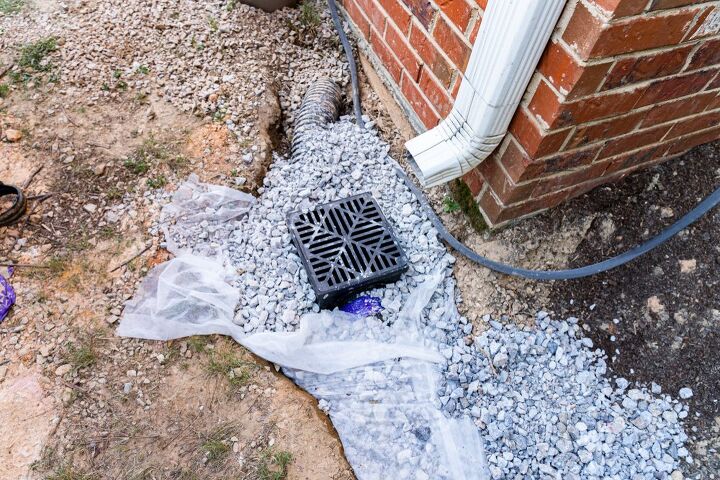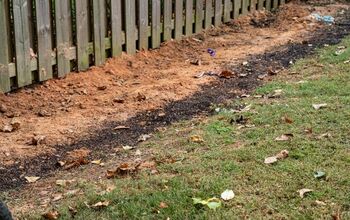Dry Well Vs. French Drain: What Are The Major Differences?

Proper drainage can protect your yard and home from soil erosion and eventually foundation damage. There are several ways to steer rainwater away from your home, but dry wells and French drains are the most popular. So, what is the difference between a dry well and a French drain?
Dry wells collect rainwater in your yard, but they only work well if you have good soil drainage. French drains direct water towards a trench at the lowest point of your yard via a perforated pipe. They both prevent soil erosion, but French drains are more effective and they can increase home value.
It’s important to have good drainage in your yard because it can save you thousands of dollars in foundation and basement repairs. Sump pumps are an effective alternative to dry wells and French drains, but they can be expensive because they require electricity. Follow along as we compare dry wells and French drains so you can decide what’s best for your home.
Do Dry Wells Actually Work?
Dry wells are mostly reliable and efficient, but they aren’t ideal for every homeowner. They can effectively dispose of rainwater in your yard. This will help mitigate soil erosion that happens when your yard has too much standing water.
However, dry wells are only effective if you have the right kind of clay and soil. Some yards with overly dense clay won’t be able to accommodate a dry well. Clay with poor drainage won’t support a dry well and it won’t be able to dispose of rainwater.
Dry wells sit at the lowest point of your yard so that rainwater can make its way there. They are a great option for homeowners with a healthy yard.
Dry Well Installation Cost
It costs an average of $3,113 to install a dry well, but it can cost as little as $1,500. Installation costs vary based on your soil quality, the size of your yard, and the contractor’s labor rate. Labor is a major cost factor because it takes lots of time and effort to install a dry well.
You will also need to obtain a permit to install a dry well and it generally costs $50. Some municipalities may not require a permit, so check your local building codes and consult your contractor. Contractors and builder-owners use concrete, stone, and plastic which make up the material costs.
You could even spend $1,000-$3,000 on concrete alone depending on how much you need for the installation. A percolation test is generally required before you can install a dry well to make sure that your soil is suitable for effective drainage. Perc tests cost $700 on average, but they can cost as little as $300 in some cases.
How do French Drains Work?
French drains are a popular alternative to dry wells that effectively serve the same purpose. A French drain is a pipe that is angled to move water away from the house and is embedded in the ground. The pipe is perforated so that it catches the percolated water.
From there, the water goes downhill to the lowest point in your yard much like a dry well. There is a termination point at the end of a French drain so that water doesn’t pool at the lowest point. Otherwise, you would risk soil erosion and yard damage where this is excessive rainwater.
French drains consist of a trench, pipe, and drainage gravel. Make sure that the trench is between 18” and 24” deep or else it is too shallow. Ideally, you should hire a professional to install your French drain system because it is a difficult process.
How Far Away From House Should French Drain Be?
Install your French drain 3 feet away from your home so that it can efficiently direct water. You don’t want to install a French drain too far from your house or your foundation may be at risk. The French drain will be able to protect the soil near your exterior walls and keep the rain out of your basement and foundation.
Never install your French drain too far away from your home or your home will be at risk. This distance also ensures that your French drain can help rainwater that comes out of your gutters. A French drain can’t adequately protect the soil under the edge of your roof if it is too close to your home.
Are French Drains Worth the Money?
French drains cost $4,500 on average, but they can cost nearly over $15,000 for some homeowners. With that said, most homeowners won’t spend more than $5,000 unless they have a large property. Many homeowners consider French drains worth the money because they can save a fortune in landscaping costs.
Soil erosion can also cause structural damage to your home and may lead to expensive foundation repairs. You could spend $8,500 or more on foundation repair due to soil erosion in extreme cases without the right damage. Gutters aren’t enough for many homeowners, especially if you live in an area with lots of rain.
French drains are worth the money for homeowners with hills and slopes in their yards. You can also protect your basement with a French drain system if it is prone to flooding when it rains. Some homeowners spend less than $1,000 on a French drain and it doesn’t hurt to call a contractor to get a quote.
Do French Drains Increase Home Value?
French drains increase home value which makes them a worthwhile investment. Prospective homeowners will appreciate that you have a French drain system. The last thing that someone wants to see when they look at a house is that the home is vulnerable to water damage.
People generally want to see that their future home will be stable and that they won’t have to spend money on repairs right away. A French drain system is a preventative measure that can appeal to possible buyers. Homes with slopes and hills in rural areas, in particular, can benefit from a French drain.
Dry wells and gutters can add value to your home as well. Drainage is an important selling point to buyers that pay attention to practical factors. Make sure to highlight your French drain system when you put your house on the market.
What’s Better Than a French Drain?
French drains are great, but sump pumps are much more effective. Sump pumps are better for homeowners that don’t have enough slope for effective drainage. You don’t have to worry about gravity directing the water with a sump pump like you would with a French drain.
Sump pumps direct the water uphill and doesn’t rely on slope and gravity for drainage. They run on electricity and automatically pump water out once it reaches a certain level. Water collects in the sump pit and it is eventually pumped out and away from your home.
They are expensive to run because sump pumps require electricity. However, sump pumps are worth the cost compared to the thousands of dollars in soil erosion and structural damage that could occur.
Why do Dry Wells Fail?
Dry wells are reliable but they can fail due to debris and clogs. They are vulnerable to clogs because they are always exposed to the elements and everything in your yard. This includes dirt, grass, dust, rocks, and pebbles.
You can stop your dry well from failing if you keep a close eye on it so that it doesn’t get clogged. The only way to be sure that your dry well is clogged is to pump it. Pump the water out and examine the dry well to see what is causing the clog.
This sounds like a lot of work, but it’s much better than having to excavate it when it’s too late. You must excavate your dry well if it’s completely clogged, so it’s ideal to observe it when you notice problems.
Summing it Up
Dry wells and French drains are both effective ways to protect your yard from soil erosion. Both systems can steer water away from your home which can ultimately protect your foundation. They also stop water from pooling in your yard which will protect your soil, grass, and plants.
Many homeowners and professionals consider French drains more effective than dry wells. That is because dry wells are primarily good for collecting rainwater from other drainage systems such as gutters. Dry wells also rely on gravity to steer the rainwater downhill where it can collect dirt and debris along the way.
The main downside to dry wells is that they get clogged over time which can lead to an expensive replacement. Otherwise, dry wells are as effective as French drains as long as you inspect them and pump the water out to check for clogs. Some homeowners prefer sump pumps over French drains and dry wells because they don’t rely on gravity.
Related Guides

Nick Durante is a professional writer with a primary focus on home improvement. When he is not writing about home improvement or taking on projects around the house, he likes to read and create art. He is always looking towards the newest trends in home improvement.
More by Nick Durante














![How Much Weight Can a 4×4 Support Horizontally? [It Depends!]](https://cdn-fastly.upgradedhome.com/media/2023/07/31/9070333/how-much-weight-can-a-44-support-horizontally-it-depends.jpg?size=350x220)












